Classic Ride: HONDA


Classic Ride: HONDA

Why being a member of a cooperative really matters.
How to turn repeat customers into referrals.

In 2023, we are organising many more opportunities to network with Members and Preferred Suppliers. These events support you to grow your business, network and keep up to date with industry news.

STAY TUNED!
Login to myCAP to check out all the upcoming events or for further information please contact our Events team.

Capricorn Preferred Supplier, Parts Connection, is proud to announce the first winners of their new “The Puzzle Game” promotion. Each time you purchase parts from any Parts Connection supplier, you'll receive a lucky Puzzle Piece. When you get one, check to see if you’re an instant $1000 winner or have earned a piece to use when playing the online Puzzle Game. Members have until 30 November 2023 to participate. The list of lucky recent winners and prizes includes:
BELL AUTOMOTIVE & ELECTRICAL IN ROTORUA - $1,000

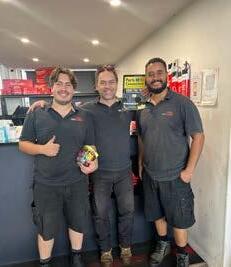
HIGH TORQUE AUTOMOTIVE SERVICES - $1,000
A big thank you to all Members who have participated in the promotion so far!
If I asked you to list your greatest achievements in business in the past 10 years, what would you say? Perhaps you’ve opened a new workshop, employed more technicians or exceeded turnover goals. Every Member’s answer would be slightly different, but no less important to the individual.
I ask because, on 1 July, we’ll be celebrating the International Day of Cooperatives, which marks 10 years since the release of the International Cooperative Alliance’s “Blueprint for a Cooperative Decade”. It was an ambitious project with admirable goals, including furthering “the economic and social progress of people, thereby contributing to international peace and security” and promoting “equality between men and women in all decision-making”.
A decade on, the follow-up report suggests that on everything from inequality to poverty to tackling climate change, cooperatives are doing an awful lot for the greater good.
It got me thinking about what we’ve achieved here at Capricorn over the past 10 years. For example, our membership has doubled from 13,000 in 2010 to more than 25,000 today across Australia and New Zealand. In 2015 we launched the Capricorn Fuel Card in New Zealand which has been a real game-changer for so many Members.
In 2014, we launched Capricorn Risk Services, which has seen the mutual protection arm of our cooperative grow enormously. The Mutual was created in 2003 to provide Capricorn Members with a competitive alternative to insurance and provides protection tailored to the motor trades industry through Capricorn Risk Services.
Thousands of you regularly use Capricorn Service Data (launched in 2016) and Autoboost (launched in 2018). Capricorn Rewards was relaunched in 2019, giving Members even more choice and variety when using their Capricorn Rewards Points. In 2022, Preferred Suppliers also gave back $4M in Preferred Supplier Bonus Points. In 2019, we paid our first trade rebate of $5 million back to Members, which had grown to a trade rebate of $15 million in 2022.

The point is, we do all of this for you, the Member. That’s what cooperatives are about—reinvesting in the communities that built them. It’s why cooperatives may just be the ideal business model for a more sustainable future.
You can read more about that between the pages of this edition of Ignition, as we celebrate the International Day of Cooperatives. You can also read some great articles that demonstrate the value we like to bring to you and your business, including an informative piece looking at how workshop management will change with the switch to electric vehicles.
CONTENTS
David Fraser Group CEO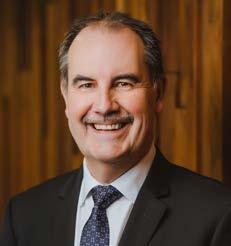
JUNE 2023
FEBRUARY 2023
6 MEASURING CUSTOMER SATISFACTION
How to turn repeat customers into referrals.
8 IS YOUR BUSINESS A TARGET FOR CYBERCRIMINALS?
New scam tactics to look out for.
10 SPECIALISATION IN THE AUTOMOTIVE AFTERMARKET
Are the days of the “all makes and models” workshop numbered?
12 2022 OPEL MOKKA-E SRI
Opel’s electrified return to the New Zealand market.
18 EV WORKSHOP MANAGEMENT
What you need to consider today for the switch to EVs tomorrow.
20 CLASSIC RIDE: HONDA SUPER CUB
Honda’s iconic Super Cub still riding high.
24 2012 TO 2022: THE COOPERATIVE DECADE
Why being a member of a cooperative really matters.
28 THE ADELAIDE MOTORSPORT FESTIVAL
A triumphant return after a three-year absence.





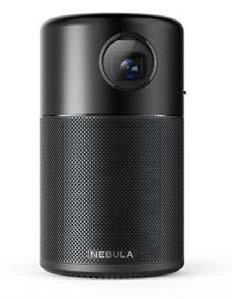




In terms of the business you do with that specific customer, the answer to that question is an actual dollar figure.
You can dive into your accounting software and work it out easily. But what about when it comes to leveraging that customer loyalty to maximise the return to your business? Then it gets a bit trickier. We’re no longer in the blackand-white world of accounting, we’re in the murky and mysterious world of marketing—including the seemingly untrackable world of “word of mouth” recommendations.
In this article, we’re going to look at how to turn those loyal (or at least repeat) customers into referrals and recommendations that bring in more business, using your existing loyal customer “assets” to boost your bottom line. Let’s start with a few basics.
Before you can leverage your loyal customers, you need to have some. Retaining customers—that is, having a customer come back multiple times, hopefully with multiple vehicles, in the long-term—is every bit as important as acquiring new customers. You will never retain an unhappy customer. So, how do you know how well you’re doing?
You measure it. Start by looking at your retention metrics, diving into your data to see how many times customers came back and when they stopped coming, and looking for any patterns to indicate when customers left (e.g., new pricing, new management, or a change in customer service approach).
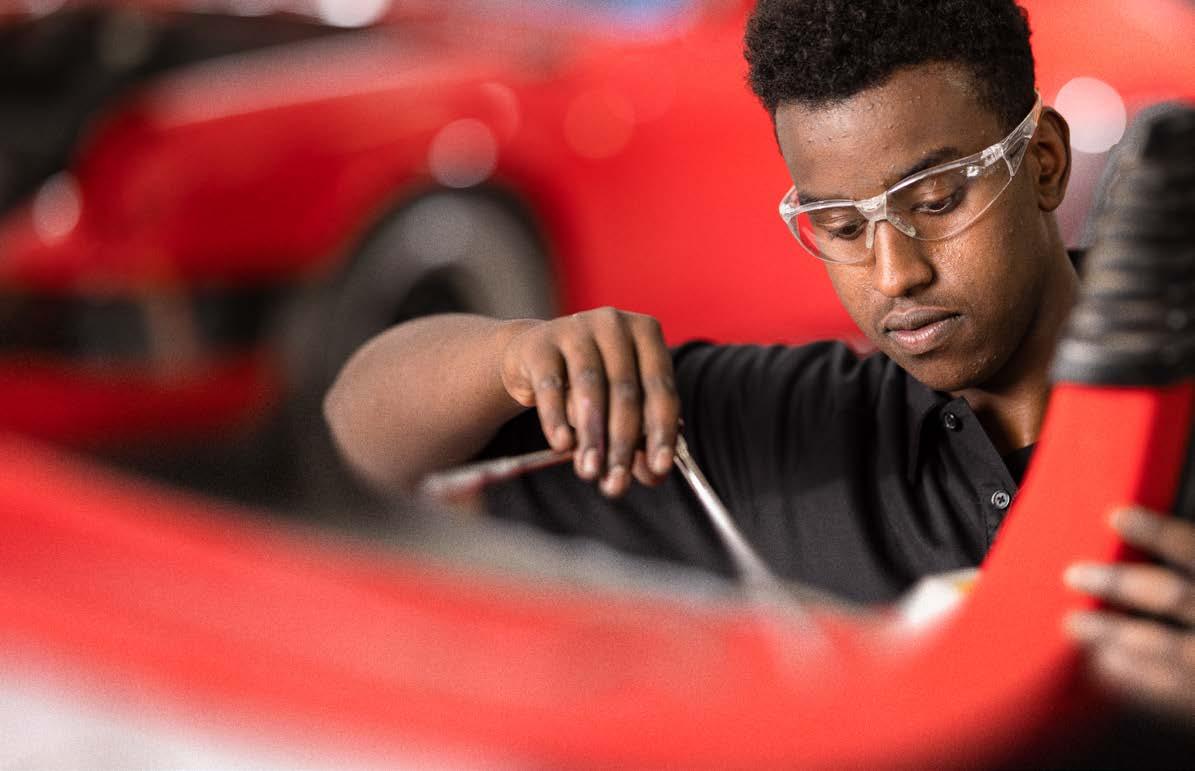
For small businesses, Chris Smoje, a Perth-based customer service expert and author of All-In Culture suggests keeping a written record of feedback, whether it’s verbal, written or through an online review, and keeping score.

You can also ask your customers. There are plenty of customer satisfaction surveys around, including Net Promoter Score, which measures a customer's willingness to advocate for your brand. It’s a useful indicator of trust and perceived value.
Don’t assume a customer is happy just because they haven’t complained. Ask for their feedback.
The quality of the feedback matters more than the data point. Four stars out of five doesn’t tell you where you went wrong, which doesn’t help you improve.
Ask specific, open and non-leading questions.
(e.g., “What did you think of the way you were greeted today?” or “What did you like about the way our service person shared their knowledge with you?”) Invite open comment replies rather than numerical rankings.
Remember, customers are comparing the service you gave them not just with other workshops, but with every other business they deal with.
There’s no point gathering all this data unless you’re going to use it to improve your customer experience. Your customers are telling you what they want, so give it to them. Use it as an opportunity to praise staff who performed well, to identify the need for more training or to introduce new customer service practices.
If customers take time to share their opinions with you, thank them. Don’t leave Google or Facebook reviews languishing without comment. Engage with the customer. Potential customers may well judge you based on your responses, rather than on the reviews themselves. When you make changes, track your customer feedback and reviews for signs of improvement.
So, back to the question at hand: How do you turn satisfied, repeat customers into advocates who refer new customers to your business?
“Just because customers keep coming back doesn’t mean they’re going to refer their friends,” Chris said. “A satisfied customer and a repeat customer may not necessarily be a loyal customer. They might just be coming to you because it’s convenient.”
Chris said there is a difference between a customer giving a recommendation when someone has asked “Do you know a good mechanic?” and saying unsolicited to someone, “You won’t believe the experience I had getting my car serviced.”
“Getting those out-of-the-blue referrals is about creating those magical or amazing moments for your customers,” Chris said. It’s the little things that can make a difference, like remembering a customer’s name and some details of their life, accommodating their needs (e.g., pick-up times and contact preferences) and taking your service beyond “expectations satisfied” to “expectations exceeded”.
“There’s got to be some sort of emotional attachment for a customer to be truly loyal,” Chris said. “You need to create those relationships, and not take customers for granted, because then it’s going to be harder for them to go elsewhere.”

Of course, strategies like “refer-a-friend” campaigns are useful tools for encouraging customers to recommend your business.
“Refer-a-friend campaigns are great because they typically attract like-minded people, so you’re getting the right kind of customer coming back in through the front door,” Chris said.
“My advice is that you still have to make it worthwhile to both parties. So, for example, if a customer refers a friend perhaps they both get 10 per cent off their next service, or something like that.”

Cybercriminals now target small to medium businesses more frequently, which means it’s more important than ever for business owners and their staff to be aware of the increasingly elaborate tactics being employed by cyber scammers.
A recent experience by a Capricorn Member illustrates the sophisticated nature of these attacks and the lengths scammers will go to. In this case, the Member received an alert on their phone that someone had tried to use their credit card; this was followed shortly by a phone call from the scammer posing as a bank employee. They spoke professionally and already had access to much of the Member’s personal information including their date of birth, credit card details, bank login name, etc.
The scammer provided this information to the Member and informed them they needed to reset their account. The scammer used the bank’s password reset system, which generated a new password that was emailed automatically to the Member. The scammer then asked the Member to provide the new code which then gave them access to the Member’s bank account where they subsequently stole $30,000.
Apart from the password reset code, the Member did not provide any information to the scammer throughout the process. The scammer was convincing due to their professional nature and the fact they had access to much of the information a bank would know about a customer.
Needless to say, this is an alarming occurrence and one that we believe all Members should be aware of and protect themselves against.
The sophisticated new scam tactics you need to be aware of.
When it comes to cybercrime, it’s tempting to think that only large businesses are the targets for hackers and scammers, but sadly this just isn’t the case.


Most of the aftermarket auto workshops that have been around for some time are marketed on the ‘all makes and models’ structure. However, the aftermarket industry is facing dramatic change at an accelerating rate, with the current focus on the transition to electric vehicles. That is not where it starts or ends. The general technology shift started many years ago, picked up speed in recent years and is now changing so quickly that just keeping up is a challenge for most workshops. New skill sets are needed to perform a wide variety of services on vehicles, opening the way to a range of opportunities for specialisation for automotive workshops and technicians. What’s more, advancements in automotive technology are creating many new niches for specialisation in such areas as electric and hybrid vehicles, driver-assistance systems, advanced electronics, programming and many more.
The ‘all makes and models’ workshop may survive for a time, but they will come to rely on specialised subcontractors to fulfil the service and diagnostic requirements of customer vehicles.
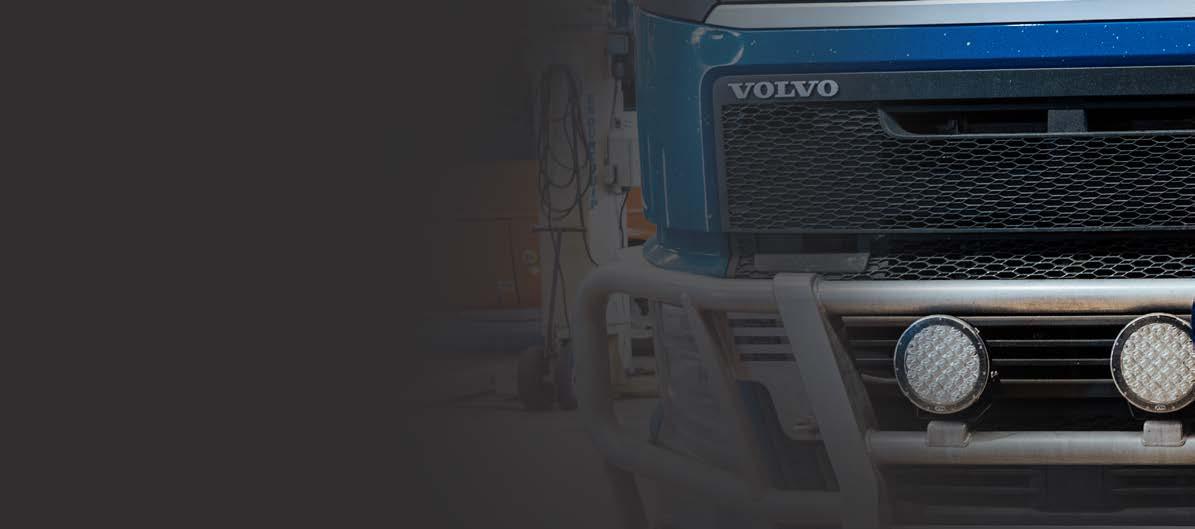
Workshops with particular skills may choose to specialise in one make or model, or even in one particular area of a vehicle. This could lead to developing a sub-business within the workshop to provide a specialised service to private or trade customers, thereby supplementing the general workshop profitability.
Planning the future of your workshop in this environment can be a little overwhelming, so the following options might help. Specialisation can deliver quite a few short- and long-term benefits as well as new opportunities.
If you adopt a specialised field such as vehicle emissions or diagnostic technology, the path is wide open to gain new customers in both retail and trade. With vehicles becoming more complex, specialising in a specific technology or automotive component could lead to opportunities to work on newer vehicles.
Workshops with the skills and training to conduct complex repairs will be able to charge more for their services. Specialisation usually leads to a smaller pool of qualified professionals being available — the law of supply and demand then has its influence on pricing.
Any decision to specialise should begin with some consideration of the workshop's overall business interests and strengths. Consider the demographics of the workshop’s location. Societies change, often with positive impact on financial status. Look at the types of vehicles in your area — maybe European vehicles are more common than they were before.
Taking on all makes and models of vehicles worked very successfully for years, but are its days numbered?
One of the main advantages of specialisation is that the business benefits from the resources and time required to specialise. Training can be more focused on a particular vehicle or component type. The workshop no longer struggles to stay on top of the changing technologies across dozens of vehicle makes — now almost impossible.

This leads to cost savings in tooling and equipment specialisation. The ‘all makes and models’ workshop has to invest in a wide range of scan tools and diagnostic equipment as well as upgrading and supporting tools. A specialised workshop may even get away with just one factory scan tool or, at most, those tools specific to the brand.

Specialisation options are limitless within the automotive aftermarket industry, pointing to a positive future for those prepared to spend the time exploring the possibilities that will be just right for your workshop.


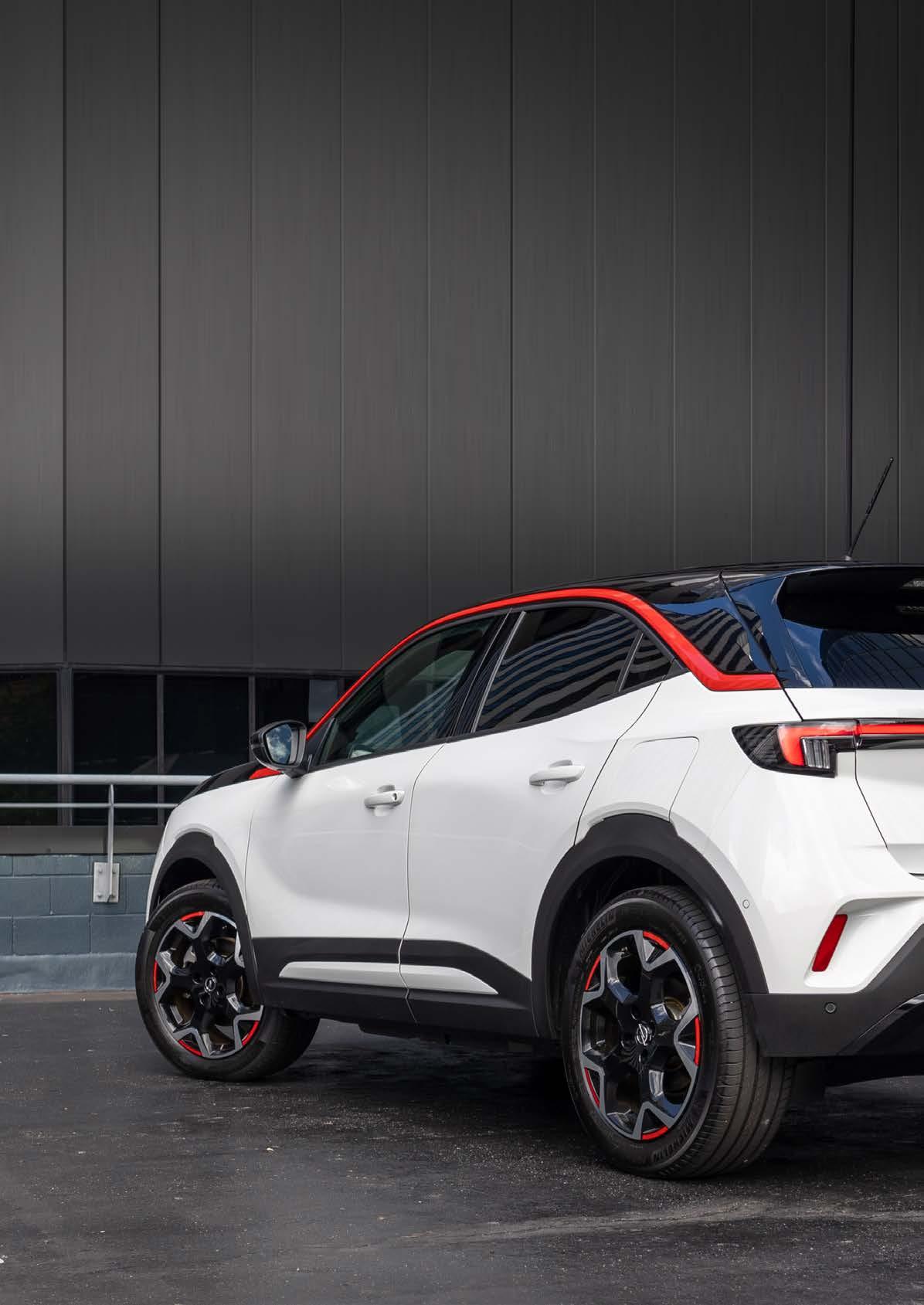
At the launch, the Mokka-e was shown as the first offering to hit our shores, a full BEV with a range of around 320km. As part of our testing, we’ll spend four days commuting in the Mokka-e, then hit the road to Cambridge and back, another 1,000km added to our testing.
How much charging will we really need to do on an open-road trip in the Mokka-e? When we say we thoroughly test cars, we mean it. Join us for 1,500 km of testing in the 2022 Opel Mokka-e.
What we like and dislike about the 2022 Opel Mokka-e SRi
What we like
we don’t like
What’s in the 2022 Opel Mokka-e SRi range?
You can pick from two petrol-engined Mokkas, or just one EV, the Mokka-e SRi.
The base model is the Edition, then there’s the SRi. These both run a 1.2-litre, turbocharged 3-cylinder motor that puts out 96 kW of power and a great 230 Nm of torque. Both are front-wheel drive and have an 8-speed automatic transmission.
For the EV model, Opel is only offering it in the top-spec SRi. This model has a 100 kW electric motor driving the front wheels, and that motor outputs 260 Nm of torque. The battery is a lithium-ion unit that has a capacity of 50 kWh. Opel suggests charging times of 28 hours from flat to full with a standard household power outlet, 7 hours with a 7.4 kW wall box charger at home, or 30 minutes with a 50 kW fast charger.
With that size battery and suggested energy consumption of 14.5kWh/100km, the Mokka-e is expected to drive around 363 km on a single charge.

As a brand, Opel made its return to New Zealand last year, promising a bunch of internal-combustion engine (ICE) cars, as well as a good selection of battery-electric vehicles (BEVs).
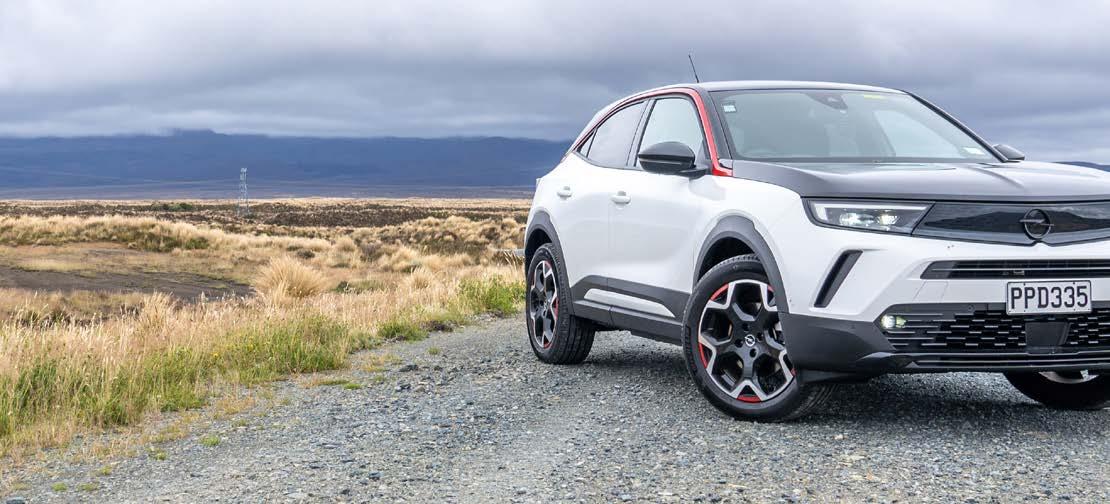
All prices below exclude the refund or additional cost of the New Zealand Clean Car Programme.


A danger of building a car on the same platform as the funky Peugeot 208, is that there’s a chance you don’t pull off an equally appealing design. This hasn’t happened with the Mokka; it looks great. It’s nicely proportioned, looks fresh and fun, and is definitely appealing to the younger market that this model is aimed for.

With nice, wide-opening front doors, the cabin initially feels quite inviting, although there is a low roof line on the Mokka, so taller people will need to duck down some.
Some might feel the red trim in the cabin is a bit too much, but with an all-black interior, the red is a refreshing and much-needed break. There’s also red stitching on the front seats, and the seats have a grey edge, again helping to break up the black. It was interesting to see that with the car at near $70K, the seats have no electric adjustment.
The dash and doors have carbon-fibre effect panels, and they don’t look too cheap or out of place at all. When you’re sitting in the driver’s seat, the leather flat-bottom steering wheel feels great to the touch. Like most newer Peugeot and Citroen models, instead of a gear lever, the Mokka has a gear selector to put the car into Drive or Reverse.
Overall, the build quality is very good with nice, tight shut lines on the body, and the interior seems well put together. One caveat to this was the roof console in our test car; it had loosened off at the rear, flopping around slightly if you touched it.
Up front, there is a single USB-A port next to a 12-volt socket for your dash cam. At the rear of the console, there is a small cubby, big enough for a few wallets but not too much more. As per Peugeot and Citroen models, the glove box has a normal-width door, but the usable size is around half of that.
Space for your rear-seat passengers is average for the class, with headroom being on the tighter side of things. While that funky design looks cool, the sloping rear roofline cuts into headspace some. Rear-seat passengers have access to two USB-A ports, although they don't have any cup holders or a fold-down armrest.
The boot is a double-height one, so you can move the floor panel up or down depending on what your storage needs are. There is no spare under the floor, just a pump and tyre repair kit. At 310 litres, the boot is reasonable for the size of the Mokka-e.

Picking up the car at 100% charged showed 328 km of range. My first four days with the Mokka-e would be commuting. That commute is a 40 km one-way journey, with a mix of suburban streets, then some city driving, then motorway, then rural. A great mix of roads, and it was excellent to see the Mokka-e return 14.1kWh/100km for that first day’s commute. That’s a great result and close to the 14.5kWh/100km that Opel claims.
The Mokka-e shines when being used as a commuter; visibility is generally very good, although the C pillar is enormous and reminds me exactly of the Mazda3. Performance is reasonable; the controls are light and mostly easy to get to and use. Adaptive cruise control is standard, and it will bring the car to a stop. There’s a ‘MEM’ button too, so if you pass a new speed limit sign, tapping the MEM button twice will set the cruise control to the new speed limit. It was good to see that traffic sign recognition on the Mokka-e was mostly faultless.
You get to pick from three drive modes in the car: Eco, Normal, and Sport. The Eco mode still has plenty of performance for everyday driving, and I often found myself selecting it when getting in to drive. When picking Eco mode, you get a dashboard warning that performance and thermal comfort will be limited, but honestly, I found little difference in either.
Obviously, Normal drive mode will see a performance increase, and choosing Sport mode will see the car leap ahead slightly, perking up like a Meerkat. Sport mode will give the car something closer to the performance you would expect out of an EV, but let’s be honest, with 100 kW of power it’s not going to be a rocket ship.

Unlike some other EVs with paddles to control your brake regeneration (regen), the Mokka-e has a small button on the console for this. Tapping that ‘B’ button will turn on the brake regen, but it’s not variable at all. It’s quite effective though — not quite one-pedal driving, but you can certainly feel the car slowing when it’s turned on. It’s a great way to get some charge back into the batteries without applying the brakes until needed.
A few days later and having driven 239 km, I had 58 km of range left, giving an effective real-world Wellington range of around 300 km. We’ve said time and again Wellington’s hills are a massive test for any EV’s range. Time to charge up to 100% for our road trip to Cambridge tomorrow, around a 500 km drive.
Hitting the road at 7 a.m., I am reminded on Transmission Gully of one superb feature of the Opel Mokka-e: driving refinement. There is almost zero wind noise and zero road noise, and tyre noise is very well suppressed. Regardless of the Mokka-e SRi being an EV, motorway driving is a near-silent affair. This fact was repeated to me over and over during the next three days and 1,000 km of driving and is absolutely a highlight of the car, and if I’m being honest, a surprising one at that.
Using Lane Positioning Assist in the Mokka-e is a variable affair; sometimes it’s perfect, maintaining a nice, straight course while it follows the lanes. At other times, it would heavily favour the centre line or the fog line, or wander a bit in its lane while trying to make up its mind where it wanted to drive. Still a handy safety feature, but I was sure to keep my grip on the steering wheel at all times. The driver gets some good dashboard options, and since the car is a top-spec SRi model, that means a digital dashboard. There are seven distinctive dashboards to choose from: Energy Flow, Minimum, Personal, Navigation, Driving, Dials, and Computer (trip computer). In most of the screens, the digital speedo is nice and large, and in Minimum, it’s enormous.
That flat-bottom steering wheel feels great to the touch and has prominent thumb grips to encourage use. The steering wheel controls are easy to use and quickly learnt.

On that long drive north, those and other controls of the Mokka-e gave me the feeling that while Opel is targeting the car to younger buyers, the car is still analogue. The controls are not old school in any way, but Opel has used controls (audio, AC, steering wheel) that are simple and effective.
The drive north also highlighted a characteristic of the Mokka-e’s donor car: a great ride.

Regardless of the car being heavier than its petrol brother, the ride was excellent and was a pleasure to experience on that long road north.
As I drove north, I thought I might make it to Turangi to do my first charge, but it was obvious early on that I wasn’t going to make it that far.
Waiourou was my next hope, but as I pulled into Taihape, I had 11 km of range left. So Taihape it was; I plugged in and set the charger going, went and had lunch and did some work on the laptop. Fifty minutes later the coffee was gone and the car was at 80% charged. It was a pretty painless stop. That first drive on the open road from a full charge looks like it got me a real-world range of around 250 km at a rate of 17.9kWh/100km.
Heading north again, I could tell I wouldn’t quite get to Cambridge, so decided to stop in at Taupo and use one of the Chargenet Hyperchargers, which pumps out 300 kW of power. The Mokka-e can’t take that much power — only the Porsche Taycan can — but it would still be better than a 50 kW charger. This is where I had issues with the Mokka-e; it refused to talk to the Hypercharger. I made a phone call to Chargenet, and they rebooted the Hypercharger and away the car went, charging at 70 kW. I sat for just 15 minutes and got the car up to 200 km of range, plenty to get to Cambridge.

After my weekend away, I recharged in Cambridge before departing and stopped off at Turangi and Bulls (and encountered some additional issues with a Chargenet Hypercharger that needed rebooting) to recharge on the way home. Finishing my journey in the dark, the Mokka-e’s Matrix LED headlights really came into their own and the intelligence around managing the car on high beams while following other drivers was superb. Such a better way to drive at night.
Seat comfort on the long trip was excellent overall. The padding is quite firm but was fine for me. There is no lumbar adjustment on the seat at all, but after doing 500 km in a day, I didn’t really miss it.
Over a total of 1,500 km of driving the Opel Mokka-e my energy economy was 16.5kWh/ 100km. Since a majority of my driving was on the open road, I think this is an excellent result.
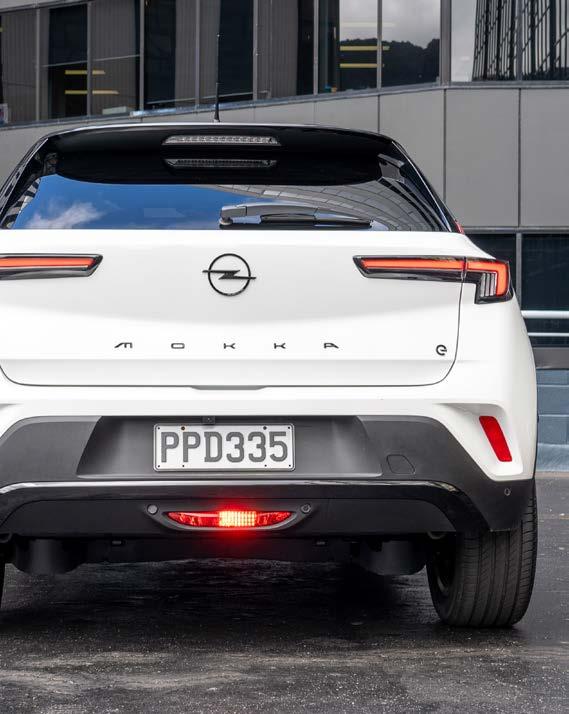
I enjoyed my time with the 2022 Opel Mokka-e more than I did with the Peugeot e-208, the very car the Mokka-e is based on. It’s hard to point out a reason, but it feels like Opel has taken what is best about the e-208 (the ride quality is a highlight), added a sexy SUV body to it, and somehow made a car that’s better than the sum of its parts.
Other than hassles with our test car using Chargenet Hyperchargers and subdued performance, my 1,000 km trip to Cambridge wasn’t too painful in extra time spent charging, and hey, the savings over petrol can’t be denied. It was around a third of the cost of using a petrol car to do the same.
But — and there’s always a but — speaking of money, paying a $25,000 premium over the Corsa SRi petrol model is a tough call. I didn’t work out how many kilometres you’d have to drive to get that $25K back, but I can tell you now it’s plenty. You really have to want the EV version to stump up that extra cash.
The 2022 Opel Mokka-e is a fun drive. Not only is it a bit of fun, but it’s also so damned refined, and for me that puts it in the running for our Surprising Car Of The Year award.

The transition to electric vehicles (EV) represents a fundamental shift in what it means to be a mechanic. But as we prepare for this major change, what will EVs mean for the way we manage our workshops?


To find out, late last year a team from Capricorn undertook a study into several key European markets where EV uptake is more advanced than it is in Australia and New Zealand. The team wanted to understand what lessons could be learned from the experiences of automotive aftermarket business owners in the UK, Norway and Sweden, and bring that information back to help Members prepare for the transition to EVs. In Norway, EVs represent over 80 per cent of new car sales and 1 in 4 cars on the road, making these markets useful to study (while also considering the nuance of each market’s characteristics).
Around the same time as the team’s visit, the State of the Nation 2022 report was released and showed 39% of Members were still seeing no EVs or hybrids at all in an average month. Those who did see EVs averaged seeing only four a month. So, the aftermarket’s engagement with EVs is still small. But, crucially, those numbers are set to increase as government policies favour the adoption of EVs and OEM EV supply chains ramp up.
Capricorn’s Chief Innovation and Transformation Officer, Kim Radalj, attended the European study. The key takeaway? Safety and training are paramount when it comes to servicing EVs.
“What we saw across all countries was a commitment to safety when handling EVs,” Kim said. “That’s because while not all service work requires access to high-voltage circuit components, being able to safely avoid those circuits requires a working knowledge of an EV’s makeup. Even modern hybrids pack a punch.”
Kim noted, “The biggest impact to workshops wanting to service EVs seemed to be the investment in people to ensure they have the right training and safety practices handling high voltage. Some tooling is required but this only starts to get super expensive if workshops are undertaking battery maintenance and repair.”
Servicing EVs is absolutely a learnable skill set, but if you want to service them in your workshop, it means an up-front investment in training. Technicians will need an understanding of batteries and a knowledge of electrical flows and concepts. Even a task as seemingly simple as powering down a vehicle so that it is safe to work on requires a certain level of upskilling. Basic training takes about 20 hours, some of which is hands-on and some of which (such as an introduction to EV systems and safety) can be delivered online from overseas.

These are important considerations for workshop management, as training not only needs to be paid for, but it also means technicians taking time away from the business. According to Kim, “Equipment estimates for non-battery repair work came in at only $5000 of equipment needed. The bigger costs were training-related and data.”
Thinking through the spatial considerations of high-voltage servicing in advance was also an important learning from the team’s visit. For example, in workshops visited on the research trip, highvoltage work needed to be cordoned off and kept separate. The team also saw examples of batteries being quarantined from the main workshop area as a form of risk management in case of thermal runaway (battery overheating that can result in smoke, fire, extremely high temperatures and/or the ejection of poisonous gas, shrapnel or particulates).
Workshops undertaking EV battery repair also need battery lifts and charging and diagnostic equipment (and the space to move this equipment around efficiently). Workshops may even choose to install dedicated chargers, but before doing so it is important to understand likely use cases for charging infrastructure.
“DC (Direct Current) is where capital outlays start to really increase but it’s generally not required by all workshops for their likely use cases,” Kim said. “In Norway where 20-25% of cars are EV, workshops are investing in charging infrastructure on the apron and adjoining car parks. In these instances, a good AC (Alternating Current) charger will often be sufficient.”
Kim said the Capricorn study found a general view that workshops were generating around 30 per cent less revenue per service. This meant a higher volume of servicing was required for workshops to cover fixed costs.
“This higher throughput can create parking congestion,” he said. “So, there are quite a few spatial considerations, including how cars were moving in and out, because the EVs were much quicker to service, too. Customers often arrive with a half charge and expect a full charge when the car is returned. This can create additional congestion as batteries are charged. Cars waiting for software updates can also be a source of congestion.”
“Motorists may not be able to drop off at the start and pick up at the end of the day because it uses up too much space. That makes the end-customer experience, including possible connections to local amenities or other transport options an important consideration for the EV era.”




ere’s a fact to impress your friends: The most produced motor vehicle in history is a motorcycle. The Honda Super Cub has been manufactured continuously since 1958. By 2017, more than 100 million of the deceptively simple step-through motorbikes had been sold worldwide.
Its enduring popularity and incredible success make the Honda Super Cub a true icon of the road. It is one of the great democratising vehicles of the 20th Century, giving millions of people— from Asia to Africa to the USA—access to a cheap and easy form of independent travel. And that’s exactly what it was designed to do.
The Super Cub story starts in 1956 when, on a trip to Germany, Honda founders Sochiro Honda and Takeo Fujisawa saw the incredible popularity of mopeds, scooters and small motorcycles. The potential for an affordable, Japanese-made motorcycle—one that was more reliable and more aesthetically pleasing than anything already on the market—was obvious. Work on the design began immediately. Honda wanted a motorbike that would appeal to the masses, could be used on both city and country roads, was powerful and reliable, and “could be ridden with one hand while carrying a tray of soba noodles in the other”.
It was the last criterion that led to the inclusion of the centrifugal clutch and semi-automatic transmission which made the Super Cub so easy to ride. As one Honda historian noted, it“took the terror out of motorcycling” for ordinary people, which ultimately helped fuel the Super Cub’s popularity.
The Super Cub C100 went on sale in 1958. It used a pressed steel monocoque chassis, with a horizontal engine placed below the central spine, allowing a step-through (or underbone) design. It was more stable than a scooter, thanks to the 17-inch wheels and the location of the motor. It has a pushrod overhead valve air-cooled fourstroke single-cylinder engine that could produce 3.4 kilowatts (4.5 horsepower) at 9,500 rpm for a maximum speed of close to 70km/h.
Sales were OK, not stellar. There was no hint of the incredible success Honda would go on to enjoy with the Super Cub. But an early problem with the initial clutch design became a huge PR win, when Honda sent out a technician to personally visit every single Super Cub owner at their home to repair the problem on-site and free of charge.
But real success would not come until a genius advertising campaign which launched in the US in 1963. The "You meet the nicest people on a Honda" campaign ran for 12 years and made people completely rethink what it meant to own and
ride a motorcycle. The advertisements eschewed the bad boy or biker image so often associated with motorcycle riding, showing women riding their Super Cubs (sold as the Honda 50 in the US) to do their grocery shopping and happy young couples riding along suburban streets. It was upbeat, respectable, suburban and middle class. It was a stroke of genius. In 1963, Honda was selling just 40,000 Super Cubs a year in the US (which was about the same number the company was producing in a single month). By 2008, sales of Super Cubs had passed 60 million worldwide.
Over the decades, surprisingly few models of the Super Cub have been released. The first variant, the C102, was launched in April 1960 and featured an electric start (as well as the kick-starting) and a coil ignition, but was otherwise the same as the earlier model. Other early iterations had similarly minor design tweaks, like enclosed front forks or square lamps instead of round ones. Different models were released in different countries and regions too, like a moped version sold in some parts of Western Europe, or a larger 100cc model made especially for Asian markets. In 2018, a new 125cc model was released in the USA, Europe and Australia featuring ABS front brake discs, LED headlights and keyless ignition. It still featured all the Super Cub's greatest hits—the step-through, the wind guards, the two-tone paint job, the old school badge and headlamp.
By 2022, the latest Super Cub C125 featured a matte grey colour scheme with red seats, a pillion seat and foot pegs as standard, a more powerful SOHC air-cooled engine (delivering 1.5L/100km) and improved suspension to “smooth out the urban” ride. In this age of Deliveroo and Uber Eats, a lot more people are delivering soba noodles on motorbikes, so that’s not a bad shout on Honda’s part.
Honda claims, with good reason, that the Super Cub’s appeal has never gone out of fashion. With more than 100 million produced and who knows how many still on the road, the Super Cub isn’t just an answer to a trivia question, it’s still the answer to many people’s travel needs all over the world. It is truly a vehicle that has earned its icon status.



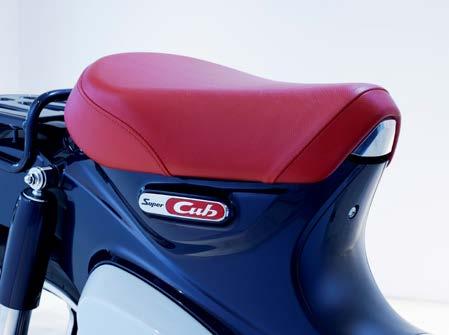
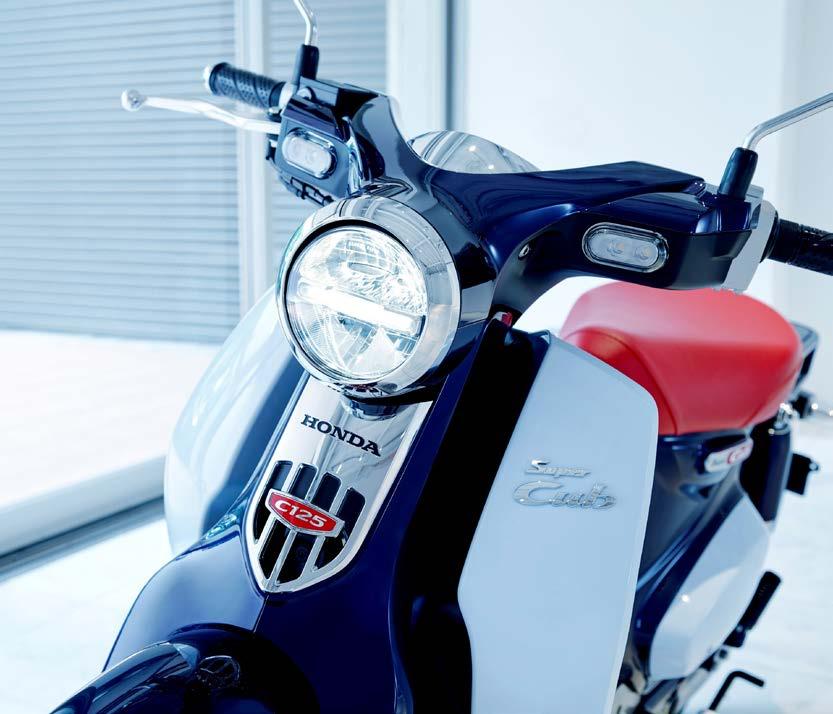

Why being a member of a cooperative really matters.
At the top of your list, you might have said “business owner”. You might think of yourself as a mechanic, even if you’re not on the tools quite so much these days. Maybe you said people manager, HR department, marketing expert, receptionist, accountant, warehouse manager or any of the other hundred jobs you do daily. But did you think about yourself as a cooperative member? Possibly not. (Although, we hope you did.)
Capricorn is one of three million cooperatives operating around the world. At least 12 per cent of all people belong to a cooperative—including you. As we prepare to mark the International Day of Cooperatives on 1 July, we wanted to take a closer look at why cooperatives—and your membership of one—really matters.
The International Cooperative Alliance (ICA), the peak body for cooperatives globally, is blunt about why cooperatives are not only a different model to traditional profit-making businesses, but a vital alternative if we’re to create a more sustainable future.
“Through self-help and empowerment, reinvesting in their communities and concern for the wellbeing of people and the world in which we live, cooperatives nurture a long-term vision for sustainable economic growth, social development and environmental responsibility,” ICA says. In short, cooperatives put people before profits.
ICA says the values that characterise cooperatives are self-help, self-responsibility, democracy, equality, equity and solidarity. “No investor-owned for-profit organisation can entirely incorporate (those values) into its culture, as much as it might try,” ICA claims. ICA also says cooperatives are based on four ethical values: honesty, openness, social responsibility and caring for others. We hope, as you read those words, they ring true for you in your experience as a Capricorn Member.
do you define yourself in business?
As a cooperative, Capricorn is deeply invested in the success of both your business and the broader automotive repair industry. If your workshop thrives, so will we and so will our Preferred Supplier network. It’s why we will continue to focus on building mutually beneficial relationships across the industry and beyond. It's why we continually look for new ways to expand our services and our offerings into benefits like Capricorn Rewards and services like Capricorn Mutual. It’s why we keep an eye on future technologies, market trends and economic data, so we can provide timely and valuable services that benefit you.
As a cooperative, we put our members’ best interests at the centre of every decision we take. For you, as a Member, it means you can always be sure someone has your back. That you will always be able to leverage the power of the collective for the good of yourself, your family and your business.
In 2012, the ICA published its Blueprint for a Cooperative Decade. It spelt out the measures that needed to be taken to spread the adoption of the cooperative model further.
The goals were lofty and admirable, including furthering “the economic and social progress of people, thereby contributing to international peace and security” and promoting “equality between men and women in all decision-making”.
A decade later, the ICA has revisited its goals and prepared a new blueprint for the decade ahead. It plans to make cooperatives both the business model preferred by people and the fastest-growing form of enterprise. It plans to do this through a combination of promotion and linking up to the UN’s Sustainable Development Goals.
ICA believes the updated blueprint provides a path for tackling some of the biggest issues facing the world today, like inequality and climate change. Take, for example, the leadership cooperatives have shown in tackling greenhouse gas emissions. According to the ICA’s World Cooperative Monitor, which tracks the activities of cooperatives around the world: “Large cooperatives contribute widely on this front (reducing greenhouse gas emissions), not only reducing their own emissions but taking action in their day-to-day operations but involving all the players in production chains in medium to long-term projects, leveraging their suppliers, members and customers to adopt low-carbon technologies and more sustainable behaviours.”
For example, major British retailer, wholesaler and insurer The Co-Operative Group plans to reduce its carbon emissions by 50 per cent by 2025 and reach net-zero emissions by 2050. The cooperative has 4.3 million active members, 65,000 employees and more than 2500 stores around the UK—so it’ll be an impressive achievement if the target is met.
Being people-focused and collectivist, cooperatives have the power to drive change and make the world a better place to live. But, even putting those lofty ambitions to one side, cooperatives also have the power to create incredible change in your business— driving efficiency and helping you keep costs low by leveraging the cooperative’s purchasing power, sound in the knowledge that when you do business with us, you’re our priority, not our profits.
So, as the International Day of Cooperatives comes around on 1 July, hopefully you’ll feel proud to be a part of Capricorn and will think of yourself as a member of a cooperative, alongside all your other important roles.
1 Participation in the Capricorn Rewards scheme is subject to the Capricorn Rewards Terms and Conditions which can be found at cap.coop/tc.



 by Paul Marinelli
by Paul Marinelli
The 2023 Adelaide Motorsport Festival took place March 25 and 26 to the delight of large crowds eager to relive the memories of the cars and drivers that competed at the Adelaide Grand Prix the city hosted from 1985 to 1995.


Using a shortened 1.6-kilometre version of the original Adelaide Parklands Street Circuit contained within the Victoria Park precinct, this bumper two-day festival had no actual races. Instead, it consists of nonstop on-track sprint sessions and demonstrations of all manner of historic racing machines linked to those magical Adelaide Grand Prix years.
This motorsport event was established in 2014 and hosted 1,800 spectators that year. Within four years it grew to attract thousands of spectators before sudden state government funding cuts abruptly ended it. Following a pre-election commitment made to restore both this event and the Adelaide 500 Supercar race, both were immediately reinstated by the newly elected Premier, Peter Malinauskas, upon his appointment to the state’s top office in March 2022.
The official start of the festival on Friday evening saw a multimillion-dollar parade of cars and motorbikes that headed from Victoria Park to East Terrace, driving along the original Adelaide Grand Prix street circuit layout. Once parked-up at East Terrace, drivers including ex-Formula One stars Stefan Johansson and David Brabham were joined by Supercar stars Craig Lowndes, Tim Slade, Todd Hazelwood and many more who mingled with the big crowd.
Highlights of Saturday included a world first, with two generations of Brabhams driving Sir Jack Brabham’s 1966 Formula One World Championship winning Brabham BT19 for the first time at the same event. Sir Jack Brabham's son David and grandson Sam both drove the BT19 in a special demonstration run.
This was the Australian-designed and Australian-built car with its locally designed and manufactured Repco engine that took on the world and won the Formula One Drivers and Constructors World Championships in the hands of Sir Jack Brabham in 1966. This was the last, and most likely only, time a driver has won the Formula One world title in a car of his own construction.
The Adelaide event also celebrated the history of the Brabham team, commemorating the team’s 30-year history in Formula One, 30 years since the team’s closure and the 40th anniversary of its last Formula One Drivers’ Championship victory by Brazilian driver Nelson Piquet in 1983.
The last Brabham Formula One car to score a Formula One podium, the 1989 Brabham BT58 Judd and the last ever Brabham Grand Prix car, the 1992 Brabham BT60B, were also on the track in Adelaide for the first time during the festival.
Other highlights included Swedish star Stefan Johansson getting back behind the wheel of the 1985 Ferrari 156/85, the Australian debut of the Rodin FZED, the first appearance of a modern IndyCar on the streets of Adelaide, the unveiling of the Airspeeder Mk4 aerial racer, Hayden Paddon demonstrating his spectacular and revolutionary Hyundai Kona EV rally car, driver signings and car launches, along with a rare appearance of Aston Martin’s incredible Valhalla concept car.
The major highlight of the 2023 Adelaide Motorsport Festival was the appearance of Alfa Romeo Formula One driver Valtteri Bottas on Sunday. Bottas thrilled crowds with some exciting laps, slips and slides on the damp track, piloting both an ’80s era Alfa Romeo GTV Group A Touring Car and the 2016 Bathurst 1000 winning Holden VF Commodore V8 Supercar.
Clearly an Aussie fan favourite (due in part to his efforts to grow a true Aussie mullet), Bottas delighted thousands of fans in his interview and signing session just one week before he heads to Melbourne to compete in the Australian Grand Prix.
The Adelaide Motorsport Festival is a mustattend event for any motor racing fan who remembers the glory years of Australia’s first world championship Grand Prix events with the cars and drivers that took part across all categories. It offers unrestricted access to the cars in a family-friendly event, with car clubs from all over the country showcasing their finest cars throughout the event as well.
Take a look for yourself at adelaidemotorsportfestival.com.au

One of Australia’s most unique motorsport events has made a triumphant return after a three-year absence.
Opened in 1939, Gee Motors Partsworld is a family-owned business based in Napier that provides high-quality used parts for Hyundai and Kia vehicles. Their team has extensive experience in the automotive parts recycling industry and takes pride in offering fast, reliable, and friendly service. With Gee Motors Partsworld, customers can rest assured that they’ll get the right part at the right price as quickly as possible.
As a business, they care about the environment and strive to minimise their impact. Gee Motors Partsworld has developed strong industry connections and superior dismantling processes, allowing them to provide competitively priced parts. They also offer nationwide delivery, ensuring that they can get the parts to you quickly and cost-effectively no matter where you are in New Zealand.
geemotors.co.nz
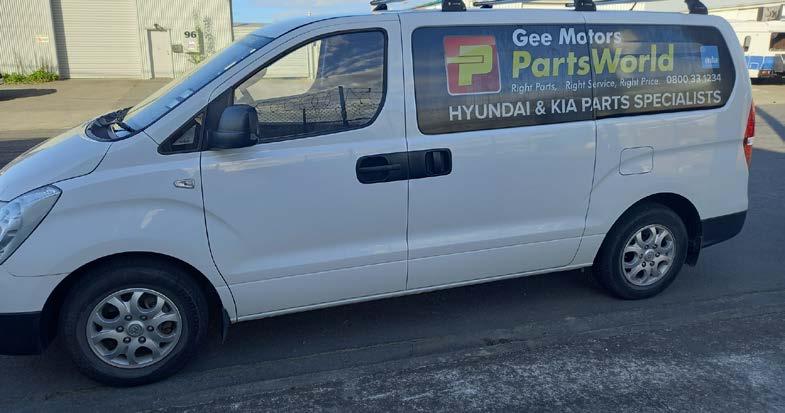
Email your entries to ignition@capricorn.coop before the 30th June 2023. Winners will be selected by a random draw of the correct Member entries occurring in West Perth on 3rd July 2023. The winners’ names will be published in the August edition of Ignition. Please ensure you include your Member number and email address when submitting your entry.

1st Prize - NORTHEND MOTORS - 4,000 points
2nd Prize - REDCLIFFE CITY AUTO - 2,000 points
LAST MONTH’S ANSWERS
Find the 15 words hidden in the jumble. They could be horizontal, vertical, diagonal or backwards. See if you can find them all!
CONSIDER COOPERATIVE CUSTOMER EDUCATE FEEDBACK HONDA MOBILITY MOTORISTS


PLAN
PRODUCTION SATISFACTION
SCAMMERS
TARGET TRANSITION VARIETY

